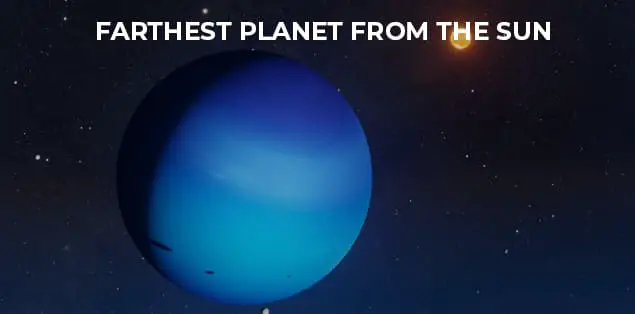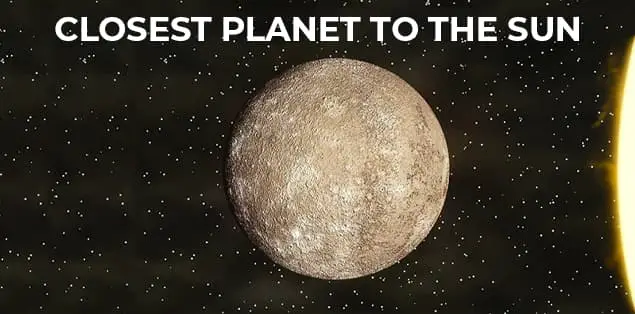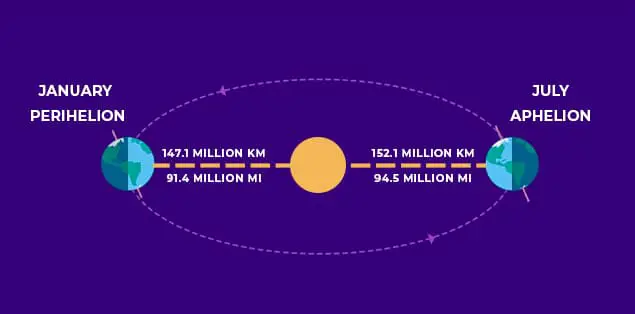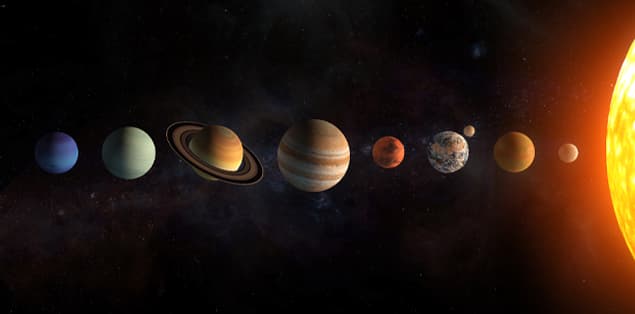Pluto is generally the farthest planet from the Sun, assuming it is still classified as a planet. However, because Pluto’s orbit is highly elliptical, there are times when Pluto’s orbital distance is less than that of Neptune. Every 248 years, this happens for around 20 years.
Neptune’s distance from the Sun was greater than Pluto’s from February 7, 1979, to February 11, 1999. Pluto is the most distant planet from the Sun at the moment, although, as you may know, Pluto was “downgraded” to dwarf planet status in August 2006.
Which Is the Most Distant Planet From the Sun?

Pluto held the accolade to be the furthest planet from the Sun for 76 years. However, this isn’t the case because of a peculiarity in Pluto’s orbit. So, which planet is farthest from the Sun? On January 21, 1979, Pluto entered Neptune’s orbit, making the latter the planet furthest from the Sun. Then, in February 1999, Pluto passed Neptune for the second time, becoming the furthest planet again.
Pluto’s orbit crosses inside Neptune’s orbit for 20 years out of every 248 years it takes to complete a complete orbit around the Sun. However, Pluto’s demotion means that the battle for the title of the furthest planet is over, and Neptune now has the title.
Pluto’s (shape) elongated orbit brings it closer to the Sun than Neptune for 20 years during its revolution, in case you’re wondering what’s going on. Pluto is closer to the Sun at its perihelion, or closest approach to the Sun, than Neptune, the eighth and farthest planet.
Which Is the Closest Planet to the Sun?

Mercury is the nearest and smallest planet to the Sun in our solar system. The Romans called the tiny planet after their swift-footed messenger deity because it has no moon and orbits the Sun quicker than the other planets.
Mercury had been known to the Sumerians for at least 5,000 years. According to a website linked to NASA’s MESSENGER (Mercury Surface, Space Environment, Geochemistry, and Ranging) mission, it was frequently identified with Nabu, the deity of writing.
Mercury was given several names depending on whether it appeared as a morning or evening star. However, Greek astronomers were aware that the two names referred to the same entity, and Heraclitus, circa 500 B.C., was correct in his assumption that both Mercury and Venus orbited the Sun rather than the Earth.
Mercury is the second densest planet after Earth, with a massive metallic core of around 2,200 to 2,400 miles (3,600 to 3,800 kilometers) in diameter, or about 75% of the planet’s diameter. Mercury’s outer shell is just 300 to 400 miles (500 to 600 kilometers) thick in comparison. For years, scientists have been perplexed by the combination of its huge core and composition, which includes an abundance of volatile elements.
What Is the Second Closest Planet to the Sun?
Venus is Earth’s nearest planetary in the neighboring region and is the second planet from the Sun. It’s one of the four inner terrestrial (or rocky) planets. Because of its size and density, it’s often referred to as Earth’s twin. However, these aren’t identical twins; there are significant distinctions between the two worlds.
Venus has a dense, toxic atmosphere packed with carbon dioxide and thick, yellowish clouds of sulfuric acid that trap heat and cause a runaway greenhouse effect. Despite its proximity to the Sun, Mercury is the hottest planet in our solar system. On Venus, the surface temperature is around 900 degrees Fahrenheit (475 degrees Celsius), hot enough to melt lead.
The surface is a rusty tint, with thousands of enormous volcanoes and strongly crushed mountains. Scientists believe that some volcanoes may still be active. Venus possesses crushing air pressure at its surface – more than 90 times that of Earth – similar to the pressure found a mile beneath the ocean on Earth.
What Month Is Earth Closest to the Sun?

The orbital path of the Earth around the Sun is not round. The orbit of the Earth around the Sun is not round. An ellipse, instead. The Earth swings closest to the Sun once a year, which makes sense. For 2022, that moment occurred on January 4 at 6:52 UTC (12:52 a.m. CST).
‘Perihelion’ comes from the Greek roots peri, meaning near, and helios meaning sun and refers to the closest distance between Earth and the Sun. We’re around 3 million miles closer to the Sun in early January, which is about 3% closer (5 million km)
So Earth is closest to the Sun every year in early January when it’s winter for the Northern Hemisphere.
What Month Is Earth Farthest From the Sun?
On July 5, 2021, the Earth will reach aphelion, our farthest point from the Sun, marking a significant milestone. So far, the summer has been scorching hot in portions of the Northern Hemisphere. Every July, in the middle of summer in the Northern Hemisphere, Earth’s aphelion occurs (and Southern Hemisphere winter). So you know that our distance from the Sun doesn’t cause Earth’s seasons it also depends on gravitational influence.
On July 5, at 22:27 UTC, we will be the furthest away from the Sun. Are you looking for the exact distance between the Earth and the Sun at aphelion? It’s at the average distance of 94,510,886 miles (152,100,527 km). The Earth at aphelion was a fraction closer last year, on July 4, 2020, at 94,507,635 miles (152,095,295 km).
The word aphelion comes from the Greek words apo, which means distant, off, or apart, and helios, which refers to the Greek god of the Sun.
What Are the Nine Planets in Order?
‘Mercury, Venus, Earth, Mars, Jupiter, Saturn, Uranus, Neptune, and Pluto’ – the planets here are in order in which they are in the solar system, starting closest to the Sun and working outward. The Sun and everything that circles it, including planets, moons, asteroids, comets, and meteoroids, make up the solar system.
The solar system begins with the sun, which the ancient Romans called Sol, and extends past the four inner planets, via the asteroid belt, to the four gas giants, and on to the disk-shaped Kuiper Belt, and beyond to the teardrop-shaped heliopause. According to scientists, the solar system’s boundary is around 9 billion miles (15 billion kilometers) from the sun. The vast, spherical Oort Cloud, which is assumed to surround the solar system, is beyond the heliopause.
The solar system begins with the Sun, which the ancient Romans called Sol, and extends past the four inner planets, via the asteroid belt, to the four gas giants, and on to the disk-shaped Kuiper Belt, and beyond to the teardrop-shaped heliopause. According to scientists, the solar system’s boundary is around 9 billion miles (15 billion kilometers) from the Sun.
The vast, spherical Oort Cloud, which is assumed to surround the solar system, is beyond the heliopause. The seventh planet Uranus and the eighth planet Neptune are also known as ice giant as giant planets composed mainly of elements heavier than hydrogen and helium, such as oxygen, carbon, nitrogen, and sulfur.
What Are Aphelion and Perihelion?
Perihelion and aphelion are terms used to describe distinct points in the Earth’s orbit around the Sun. Keep in mind that the Earth orbits the Sun in an elliptical, not circular, manner. This means that in January, at its closest position, the Earth is nearly 3 million miles closer to the Sun than in July, when it is at its furthest point.
- The aphelion is the farthest point in the Earth’s orbit from the Sun.
- Perihelion is the closest point on the Earth’s orbit to the Sun.
Aphelion and Perihelion on Mars
The terms aphelion and perihelion are most commonly associated with Earth because it is our home planet. However, they are equally applicable to other planets orbiting the Sun. Every planet has a point in its orbit where it is the furthest or nearest to its star. For example, Mars’ orbit is significantly more elliptical than Earth’s moon. Earth’s moon orbit appears practically circular in comparison; this almost-circular orbit may explain why Earth’s climate is relatively stable, assuming hydrostatic equilibrium.
Mars has four seasons as well, but they last twice as long because it takes Mars (the red planet) two Earth years to orbit the Sun. Because Mars is closest to the Sun during the end of southern spring, the southern hemisphere of Mars enjoys a warmer, shorter spring and summer than the northern hemisphere. Because Mars is closest to the Sun during the southern winter. It moves more slowly in its elliptical orbit around the Sun.
It can be extremely dramatic for Mars to transition from a colder winter to a warmer spring.
Which Planet Has the Shortest Orbit Around the Sun?
Mercury has the shortest orbital period of all the planets (year). The innermost planet in our Solar System completes its highly elliptical orbit around the Sun every 87 (Earth) days 21 hours.
Mercury has the most eccentric orbit of any planet in the Solar System, reaching within 46 million kilometers (28.58 million miles) of the Sun at its closest point (perihelion) before swinging out to 69.81 million kilometers (48.38 million miles) at its furthest point (aphelion).
Mercury’s eccentric orbit causes its orbital velocity to vary dramatically during the year. Mercury travels at a speed of 139,896 km/h as it approaches aphelion when traveling away from the Sun (86,927 mph). Its speed reaches 212,328 km/h at perihelion when pushed deeper into the Sun’s gravity well (131,934 mph).
Mercury’s rotation and its day-night cycle do not match up because of its narrow orbit around the Sun and its extremely lengthy rotation time and in radial directions (it spins on its axis once every 1,406 hours or 58 Earth days). On Mercury, a whole day-night cycle takes 176 Earth days.
Final Words – Which Planet is Farthest From the Sun?
What would you observe once you reached the Solar System’s farthest reaches, leaving the Sun behind?
We’ll probably never know for sure what the farthest objects in the Solar System are. Still, it’s most likely one of the comets that came close to the Sun many years ago and then disappeared into the solar system’s outer reaches, never to be seen again. Suppose we limit our choices to things we can see from a considerable distance. In that case, we can limit our choices to ‘permanent’ members of the Solar family or celestial body.
Neptune is our Solar System’s farthest planet from the Sun; however, there are dwarf planets further out, including Pluto. Pluto’s orbit has a significantly longer elliptical than the other planets’, meaning it is closer to the Sun for 20 years out of its 249-year orbit than Neptune (the eighth planet). Eris, the furthest currently identified dwarf planet, lies beyond planet Pluto.
